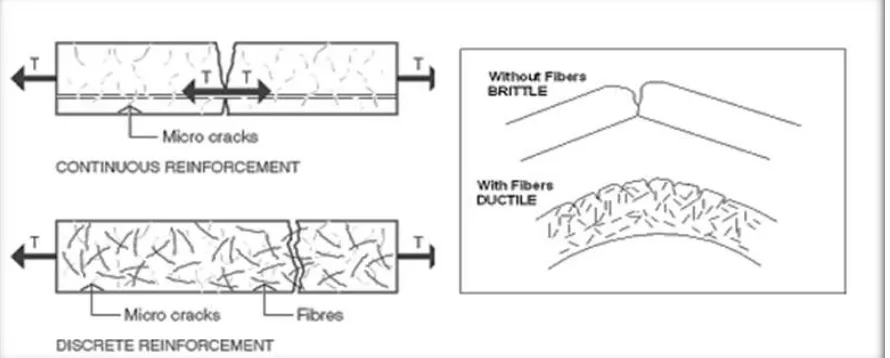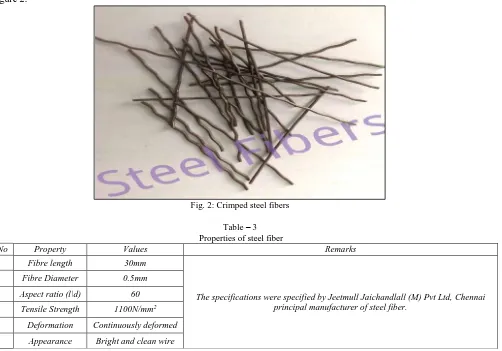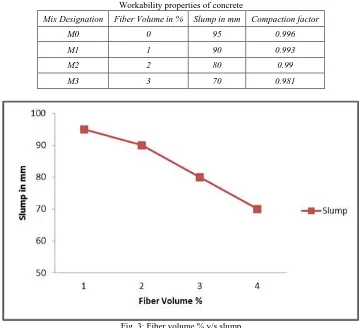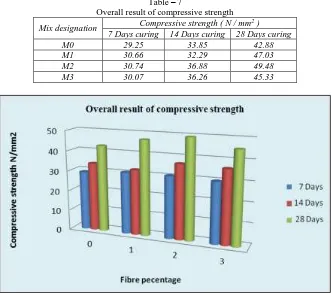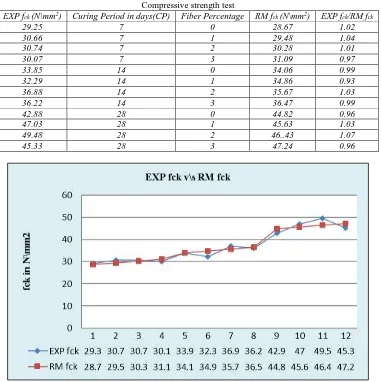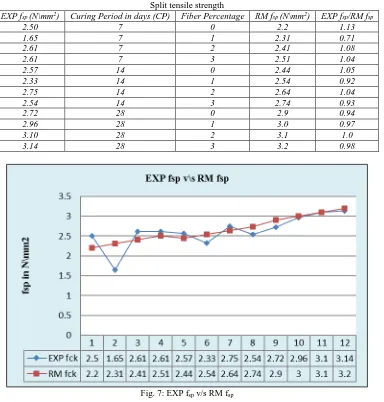Experimental Study on the M20 Grade Cement
Concrete Containing Crimped Steel Fibres
Harish B A Siddesh T M
Assistant Professor PG Student
Department of Civil Engineering Department of Civil Engineering
GMIT, Davanagere-577006, Karnataka, India UBDTCE, Davanagere-577004, Karnataka, India
Hanumesh B M Siddhalingesh B K
PG Student PG Student
Department of Civil Engineering Department of Civil Engineering
UBDTCE, Davanagere-577004, Karnataka, India UBDTCE, Davanagere-577004, Karnataka, India
Abstract
Plain Portland cement concrete is a brittle material. The strength of concrete in tension is much lower than in compression. A growing tensile crack in plain concrete can very soon lead to failure. In the presence of reinforcement, the tensile load is transferred to the steel. An alternative to increasing the load carrying capacity of concrete in tension is the addition of fibers. Well dispersed fibers in concrete act to bridge the cracks that develop in concrete. The incorporation of fibers in a cement matrix leads to an increase in the toughness and tensile strength, and an improvement in the cracking and deformation characteristics of the resultant concrete. An attempt has been made to investigate the influence of crimped steel fibers of aspect ratio 60 on the compressive and split tensile strength for M20 grade of concrete. Few Regression Models were deduced to estimate the strengths for CSFRC with respect to curing period and percentage of fiber. Conclusions are made by comparing the experimental and analytical results.
Keywords: Aspect Ratio, Compressive Strength, Regression Models, Steel Fibres, Split Tensile Strength
________________________________________________________________________________________________________
I. INTRODUCTION
II. LITERATURE REVIEW
“Experimental investigation on steel fiber reinforced concrete using metakaolin” Yogesh ulape, Giridhar naruli, (April 2015)
The experimental work which is been carried out to evaluate mechanical properties of steel fiber reinforced concrete using metakaolin. Effect of steel fibres and metakaolin on mechanical properties of concrete is also studied. Fiber content is varied from 0.25 to 1% at an interval of 0.25% by volume of concrete. The metakaolin is used at 15% by weight of cement. Various mechanical properties considered for investigation are compressive, split tensile and flexural strength. For these total 15 cubes, 15 cylinders and 15 beams are casted. All the specimens are cured for the period of 28 days. The workability is measured using slump cone test. The test results of steel fiber reinforced concrete using metakaolin are compared with control concrete.
“Comparison of performance of standard concrete and fiber reinforced standard concrete exposed to elevated temperature” K.Srinivasa Rao, S.Rakesh Kumar A. Laxmi Narayana (2013)
Concrete elements exposed to fire undergo temperature gradients and as a result, undergo physical changes or spalling which leads to expose steel reinforcement. This causes distress in concrete structures. The performance of concrete can be improved with the addition of steel fibre to concrete especially when it is exposed to heat. Therefore, this study has been carried out to generate experimental data on standard concrete of grade M45 and Fiber Reinforced Standard Concrete exposed to elevated temperatures. For each type of concrete six sets of cubes, cylinders, and beams have been cast. Each set contains 5 specimens. A total of thirty cubes, thirty cylinders, and thirty beams of Standard Concrete and Fiber Reinforced Standard Concrete have been cast, out of which 5 sets of standard concrete and fiber reinforced standard concrete are exposed to elevated temperatures of 500C, 1000C, 1500C, 2000C and 2500C for 3 hours and the sixth set is tested at room temperature as control concrete. These specimens have been tested for compressive strength, split tensile strength, and flexural strength in hot condition immediately after taking out from oven. The results are analyzed and final conclusions are drawn.
“Streangth properties of glass fiber concrete” Chandramouli k, Srinivasa Rao P, Pannirselvam N, Sravana P. (April 2010)
The present day world is witnessing the construction of very challenging and difficult civil engineering structures. Quite often, concrete being the most important and widely used material is called upon to possess very high strength and sufficient workability properties. Efforts are being made in the field of concrete technology to develop such concretes with special characteristics. Researchers all over the world are attempting to develop high performance concretes by using fibre and other admixtures in concrete up to certain proportions. In the view of the global sustainable developments, it is imperative that fibre like glass, carbon, polypropylene and aramid fibre provide improvements in tensile strength, fatigue characteristics, durability, shrinkage characteristics, impact, cavitations, erosion resistance and serviceability of concrete. Fibre impart energy absorption, toughness and impact resistance properties to fibre reinforced concrete material and these characteristics in turn improve the fracture and fatigue properties of fibre reinforced concrete research in glass fibre reinforced concrete resulted in the development of an alkali resistance fibre high dispersion that improved long term durability. This system was named alkali resistance glass fibre reinforced concrete. In the present experimental investigation the alkali resistance glass fibre has been used to study the effect on compressive, split tensile and flexural strength on M20, M30, M40 and M50 grades of concrete.
“Steel fibres reinforced high performance concrete beam – column joints subjected to cyclic loading” by N. Ganesan, P.V. Indira and Ruby Abraham (Sep 2007)
This paper describes the experimental results of ten steel fiber reinforced high performance concrete (SFRHPC) exterior beam-column joints under cyclic loading. The M60 grade concrete used was designed by using a modified ACI method suggested by Aïtcin. Volume fraction of the fibre used in this study varied from 0 to 1% with an increment of 0.25%. Joints were tested under positive cyclic loading, and the results were evaluated with respect to strength, ductility and stiffness degradation. Test results indicate that the provision of SFRHPC in beam-column joints enhances the strength, ductility and stiffness, and is one of the possible alternative solutions for reducing the congestion of transverse reinforcement in beam column joints. Also, an attempt has been made to compare the shear strengths of beam-column joints obtained by using the models proposed by Tsonos and co-workers, Bakir and co-co-workers, and Jiuru andco-workers. As these models are meant for the joints in ordinary concrete, comparison was not found to be satisfactory. The model proposed by Jiuru and co-workers was modified to account for the presence of high performance concrete. The proposed model was found to compare satisfactorily with the test results.
III. MATERIAL DETAILS
Cement
Table – 1
Physical Properties of cement
Sl.No Property Test method Result Standard Limits as per IS:8112-1989
1 Specific gravity Specific gravity bottle 3.15 -
2 Standard consistency
Vicat Apparatus
27 % -
3 Initial setting time 48 min Not less than 30 min
4 Final setting time 230 min Not more than 600 min
5 Fineness Sieving 7% Maximum 10 %
6 Soundness Le-Chatelier Apparatus 4 mm Maximum 10 mm
Fine Aggregate
Aggregate passing the 4.75 mm sieve & predominantly retained on the 75 micron sieve. Sand is fine with fineness modulus of 2.22 and conforming to grading zone I of table 4 of IS: 383-1970.
Table – 2 Properties of fine aggregate
Sl. No Property Result Remarks
1 Specific gravity 2.61 Avg. Specific gravity of the rocks vary from 2.6 to 2.8
2 Fineness modulus 2.22 A sand having a fineness modulus more than 3.2 will be unsuitable for making satisfactory concrete
3 Zone III Grading limit of fine aggregates as per IS:383-1970
Coarse Aggregate
These particles that are predominantly retained on the 4.75mm sieve are called coarse aggregates.
Locally available coarse aggregates are used of 20 mm down size. The specific gravity of coarse aggregate was found to be 2.75.
Steel fiber
It is a one of the most commonly used fiber. Generally, round fibres are used. The diameter may vary from 0.25 to 0.75 mm. the steel fibres are likely to get rusted and lose some of its strengths. But investigations have shown that the rusting of the fibres take place only at the surface. The steel fibres were purchased from Jeetmull Jaichandlall (M) Pvt Ltd, Chennai. The sample is shown in Figure 2.
Fig. 2: Crimped steel fibers Table – 3 Properties of steel fiber
Sl.No Property Values Remarks
1 Fibre length 30mm
The specifications were specified by Jeetmull Jaichandlall (M) Pvt Ltd, Chennai principal manufacturer of steel fiber.
2 Fibre Diameter 0.5mm
3 Aspect ratio (l\d) 60
4 Tensile Strength 1100N/mm2
5 Deformation Continuously deformed
Mix design as per IS: 10262-2009
Table – 4 Mix Proportion
w/c ratio Cement Fine aggregate Coarse aggregate
0.45 437.77 kg/m3 639.73 kg/m3 1131.16 kg/m3
1 1.46 2.58
Table – 5 Concrete mix designation
Mix designation Description
M0 Controlled concrete of grade M20
M1 1% CSFRC
M2 2% CSFRC
M3 3% CSFRC
Where M=Mix CSFRC= Crimped Steel Fiber Reinforced Concrete
IV. EXPERIMENTAL RESULTS
Study on Fresh Properties of Crimped Steel Fiber Reinforced Concrete
The concrete mixes were prepared based on the mix proportions of Table 5 workability of all mixes were observed in terms of slump and compaction factor. These results are reported in Table 6.
Table – 6
Workability properties of concrete
Mix Designation Fiber Volume in % Slump in mm Compaction factor
M0 0 95 0.996
M1 1 90 0.993
M2 2 80 0.99
M3 3 70 0.981
Fig. 3: Fiber volume % v/s slump
Study on Strength Properties of Crimped Steel Fiber Reinforced Concrete Compressive Strength Test
Table – 7
Overall result of compressive strength Mix designation Compressive strength ( N / mm
2 ) 7 Days curing 14 Days curing 28 Days curing
M0 29.25 33.85 42.88
M1 30.66 32.29 47.03
M2 30.74 36.88 49.48
M3 30.07 36.26 45.33
Fig. 4: Overall result of compressive strength
Split Tensile Strength Test
For each concrete mix, the split tensile strength is determined on two150mm diameter and 300mm height cylinders at 7, 14 and 28 days of curing. Following table give the split tensile strength test results of controlled concrete & and steel fibre reinforced concrete produced with 1, 2 and 3 percentages of fibre.
Table – 8
Overall result of split tensile strength Mix designation Split tensile strength ( N / mm
2 )
7 Days curing 14 Days curing 28 Days curing
M0 2.50 2.57 2.72
M1 1.65 2.33 2.96
M2 2.61 2.75 3.10
M3 2.61 2.54 3.14
Regression Models
To correlate experimental results with theory, a theoretical study is carried out. Few Regression Models were deduced by using Origin Pro 7.0. (Scientific Graphing and Analytical software). Origin is the data analysis and graphing software of choice for over half a million scientists and engineers in commercial industries, academia and government laboratories worldwide. Origin offers an easy to use interface for beginners, combined with the ability to perform advanced customization as you become more familiar with the application.
Compressive Strength Test
fck = 23.292+0.769(CP)+0.805(% fiber) (1) Where, fck = 28 days cube compressive strength in N/mm2
CP = Curing period in days.
% fiber = Volume fraction of steel fibers.
Comparison between the test results and that predicted by proposed equations are presented in Table 9. The ratio between EXP/RM is about 0.93 to 1.07. From this it came to know that the proposed equations are made good agreement with the experimental results.
Table – 9 Compressive strength test
EXP fck (N\mm2) Curing Period in days(CP) Fiber Percentage RM fck (N\mm2) EXP fck/RM fck
29.25 7 0 28.67 1.02
30.66 7 1 29.48 1.04
30.74 7 2 30.28 1.01
30.07 7 3 31.09 0.97
33.85 14 0 34.06 0.99
32.29 14 1 34.86 0.93
36.88 14 2 35.67 1.03
36.22 14 3 36.47 0.99
42.88 28 0 44.82 0.96
47.03 28 1 45.63 1.03
49.48 28 2 46..43 1.07
45.33 28 3 47.24 0.96
Fig. 6: EXP fck v/s RM fck
Split Tensile Strength Test
fsp = 1.9753+0.0304(CP) +0.1(% fiber) --- (2) Where, fsp = 28 days split tensile strength in N/mm2
CP = Curing period in days.
% fiber = Volume fraction of steel fibers.
Table – 10 Split tensile strength
EXP fsp (N\mm2) Curing Period in days (CP) Fiber Percentage RM fsp (N\mm2) EXP fsp/RM fsp
2.50 7 0 2.2 1.13
1.65 7 1 2.31 0.71
2.61 7 2 2.41 1.08
2.61 7 3 2.51 1.04
2.57 14 0 2.44 1.05
2.33 14 1 2.54 0.92
2.75 14 2 2.64 1.04
2.54 14 3 2.74 0.93
2.72 28 0 2.9 0.94
2.96 28 1 3.0 0.97
3.10 28 2 3.1 1.0
3.14 28 3 3.2 0.98
Fig. 7: EXP fsp v/s RM fsp
V. CONCLUSIONS
Following important conclusion have been drawn from the experimental studies carried out to investigate the influence of crimped steel fibres on strength characteristics of concrete.
1) From the test result, it is observed that both compressive and split tensile strength of concrete increases with increases in percentage of steel fibres.
2) The workability of fresh concrete was found to decrease with an increase in the crimped steel fibre.
3) Plain concrete shown brittle failure. However, CSFRC has shown ductile failure with considerably improvement in post cracking strength.
4) Crimped steel fibres are more effective than straight fibres due to excellent anchorage which increases the ultimate strength. 5) The addition of fibres increases the density of concrete.
6) Proposed regression models presented herein are having good compatibility with the experimental results.
VI. SCOPE FOR FUTURE WORK
1) In the present study M20 grade concrete was considered, the present work can be extended for higher grades of concrete. 2) In the present study crimped fibres of aspect ratio 60 of steel fibers (by mass) were considered, the present work can be
extended for different aspect ratios.
3) In the present study 1%, 2% and 3% of crimped steel fibers (by mass) were considered. The present work can be extended for higher percentage of steel fibres.
REFERENCES
[1] Chandramouli k, Srinivasa Rao P, Pannirselvam N, Sravana P. (April 2010) “Streangth properties of glass fiber concrete”.
[2] K.Srinivasa Rao, S.Rakesh Kumar A. Laxmi Narayana (2013) “Comparison of performance of standard concrete and fiber reinforced standard concrete exposed to elevated temperature”.
[3] N. Ganesan, P.V. Indira and Ruby Abraham (Sep 2007) “Steel fibres reinforced high performance concrete beam – column joints subjected to cyclic loading”
[4] Yogesh ulape, Giridhar naruli, (April 2015) “Experimental investigation on steel fiber reinforced concrete using metakaolin”. [5] IS: 10262 -2009 “Concrete mix proportioning”.
